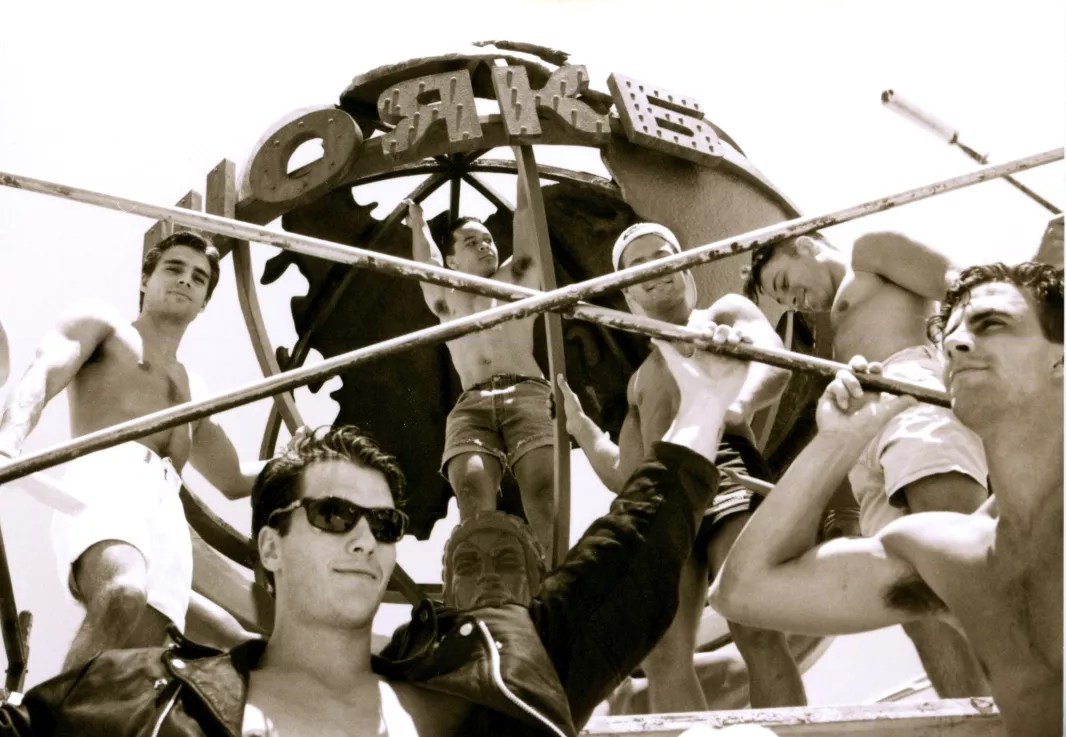
Steven Rogers

Audio By Carbonatix
Nightclub owner Steven Rogers has a hard time getting rid of things. That’s immediately evident when visiting the central Phoenix warehouse filled with remnants of the numerous bars and clubs he’s opened in the past three decades.
“I’m sort of an organized hoarder,” Rogers says while walking through the collection.
Rogers eventually comes upon a collection of light fixtures that hung from the ceiling of The Works, the defunct Scottsdale dance club from the ’90s he co-owned with former business partner Greg Walker. It’s known as Rogers’ most famous project – an influential spot that was unique for its time.
“The Works was my biggest success. It wasn’t my biggest financial success, but was important for myself and others,” Rogers says. “People tell me stories about the club all the time, like ‘I met my wife there.’ It’s just weird to build a nightclub and find out how it changed their lives. I gave them a platform for that.”
After debuting in 1992, The Works was a hangout for local club kids and ravers, a destination for the LGBTQ community, and a safe space for weirdos and outcasts. They all came to dance, party, and go wild.
It also helped launch two of the biggest DJs to come out of the Valley, Eddie Amador and Markus Schulz. The latter artist, who served as The Works’ resident DJ until its closure in 1998, says it prepared him for EDM superstardom.
“I really think fondly back at the days at The Works because I would try different things and see how it felt, whereas in a lot of [other] places I wouldn’t have been able to do that because you’re judged right away,” says Schulz.
Phoenix New Times has assembled an oral history of The Works in honor of Schulz returning to the Valley this weekend for a performance at Shady Park in Tempe.
(Editor’s note: Some quotes have been condensed and edited for brevity and clarity.)
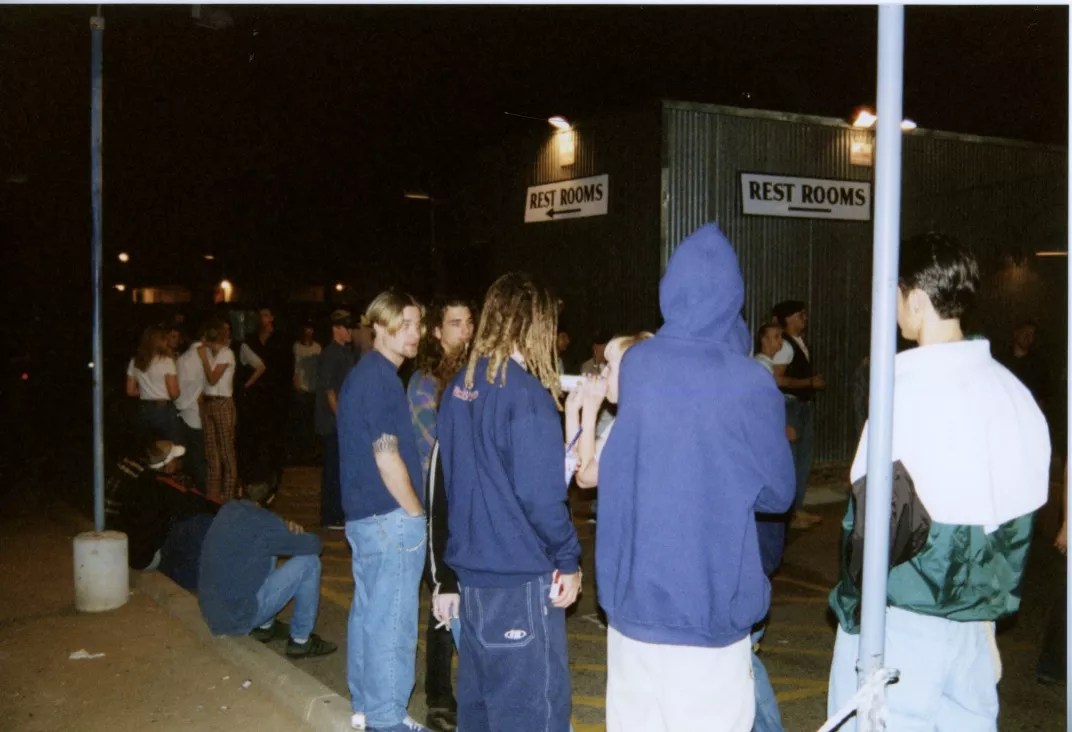
Club kids gathered outside of The Works.
Steven Rogers
In 1991, Steven Rogers and then-business partner Greg Walker owned a pair of bars, Club UM in Tempe and The Zone in Scottsdale. Rogers had his issues with both.
Steven Rogers, co-owner of The Works: I was really frustrated at the time because I had a college bar on Mill Avenue [Club UM] with a lot of frat boys that tore the place apart. And then, I built a place in the Scottsdale Galleria called The Zone, this comedy club, bar, and restaurant. It was very Scottsdale yuppie. And frankly, I didn’t identify with either one.
And I was having problems with the city of Tempe with running after-hours [at Club UM]. We had after-hours there, but last call was at 1 a.m. then. They wanted to roll up the sidewalks after one o’clock. [Club UM] burned to the ground and we rebuilt it, but Tempe changed the after-hours laws to screw us over. We were so furious and it wasn’t a priority to me anymore. So I said, “Why don’t I do something for myself?”
In 1991, Rogers and Walker began leasing a 14,000-square-foot building off of Scottsdale Road and Second Street, the onetime home of now-defunct theater company Actors Lab Arizona. The pair transformed the place into The Works.
Rogers: The Works was something I’ve talked about and talked about and wanted to do. I always thought, if you always follow your passion and you do it as pure art as opposed to practicality and making money, then the universe sort of provides. And The Works was a good example of that.
Markus Schulz, former resident DJ at The Works: There were two owners [of The Works], Greg and Steven. And Greg loved the rave scene and Steven was more into the [LGBTQ] scene.
Rogers: Scottsdale was different back then. There were saloons, like the Rusty Spur, and other bars, but no real places to dance.
Sloane Burwell, former club kid and regular at The Works: There was no Scottsdale club scene back then. There were tons of raves, but the only dance clubs that existed was the stuff DJ Randall was doing and the Silver Dollar Club in downtown Phoenix, which was all basically underground and low-budget. It was super punk rock.

Steven Rogers (right), co-owner of The Works.
Steven Rogers
Eddie Amador, former resident DJ at The Works: The Silver Dollar was a place where artists could do what they wanted. At the time, we were the early underground; we weren’t commercial. People didn’t know what house music was yet. It was just beginning in New York, Chicago, and L.A. This was right before the rave scene blew up. So we were doing a weekly or monthly thing at the Silver Dollar. I was just this geeky, skinny Mexican kid spinning house.
Rogers: I was a fan of the Silver Dollar. There were bikers, drag queens, and this rave DJ. It was a small bar, but done in a very eclectic, crazy, fanciful way. And I was like, “I want to do this, but on a big scale.” To me, the birth of The Works came a bit out of me going to the Silver Dollar.
Amador: Steven heard about it and came to the [Silver Dollar] one night. And although we didn’t talk that first night, he definitely had something boiling in his mind about The Works. That was the concept, to take that underground thing to a larger level. Steven saw how big it was in New York; he went to all the mega-clubs at that time and knew what was going on there.
Rogers: When I opened [The Works], I opened with the doorman from the Silver Dollar and Eddie [Amador].
Amador: There was a middleman between me and Steven. That was [the late] Vince Johnson. He was this outgoing fellow, very social, very nice. He’d come to the Silver Dollar and talk about how much he liked my music. The Silver Dollar was dying at that point; it was about the time they were breaking ground for [America West Arena, now Talking Stick Resort Arena].
One night, the cops busted in at 1:30 in the morning and we all had to get out. And good ol’ Vince pulled up in a stretch limo outside, this big white car, and said, “Get in, get in.” I jumped in and Vince was like, “We’re going to start The Works.” And I was like, “Sounds good to me,” since I didn’t know where I was going to play since the Silver Dollar was over.
Burwell: Vince Johnson managed The Works for Steve. I first heard about it at [Club UM] when he was there handing out fliers. They really pitched it as this super-club and it seemed like a big deal.
Rogers: I was cleaned out at the time. So when we opened The Works, I got people to give me extra time to pay them back [for equipment]. It was almost like a payment plan. It was really a labor of love.
“The Works, as they say, is hot. It’s also steamy and sweaty. And as near as anyone can determine, it’s the only club in town where, if the mood strikes them, clubgoers are encouraged to shuck their duds and dance in their Skivvies.” – Dewey Webb, 1992
The Works debuted in the spring of 1992 and was welcomed by local club kids and members of the LGBTQ community.
Burwell: A bunch of my friends went to the opening. It was fantastic. They had real lights, they had dance risers for people, they had a legit, fantastic sound system.
Ryan Jeffs (a.k.a. DJ Inertia), former regular at The Works: I think I came down there when it first opened to talk to [Vince] about DJing there. I remember walking into the main room and being overwhelmed at the sheer size of the club itself. It had a warehouse feel to it, just this big, square room with very tall ceilings, giant disco ball in the middle. It was ginormous.
Burwell: The inside was really cool. It looked all metallic and industrial and super-modern, like something out of Metropolis magazine. There were catwalks; there were lasers everywhere.
Schulz: Gary Bardonia was the light man on day one. He came from a theater background and was a very creative part of what they were doing musically and vibe-wise. With the lighting, with the music, he wanted every night to be theater. He’d set the lighting so it was perfect before doors even opened. Nobody entered that club until the lighting and the mood and everything was saturated in the right way. And then it was like, “Okay, now the doors can open.”
Amador: It was very New York with after-hours and everything. I played Friday and Saturday nights, from 9 o’clock to, like, 7 a.m., straight through. I didn’t know how mega-clubs were like, but Steven did. I was just this underground kid. I played the first year with a boombox as my mixer to cue my music over this pimp, 100,000-watt [sound] system that was state of the art back then.
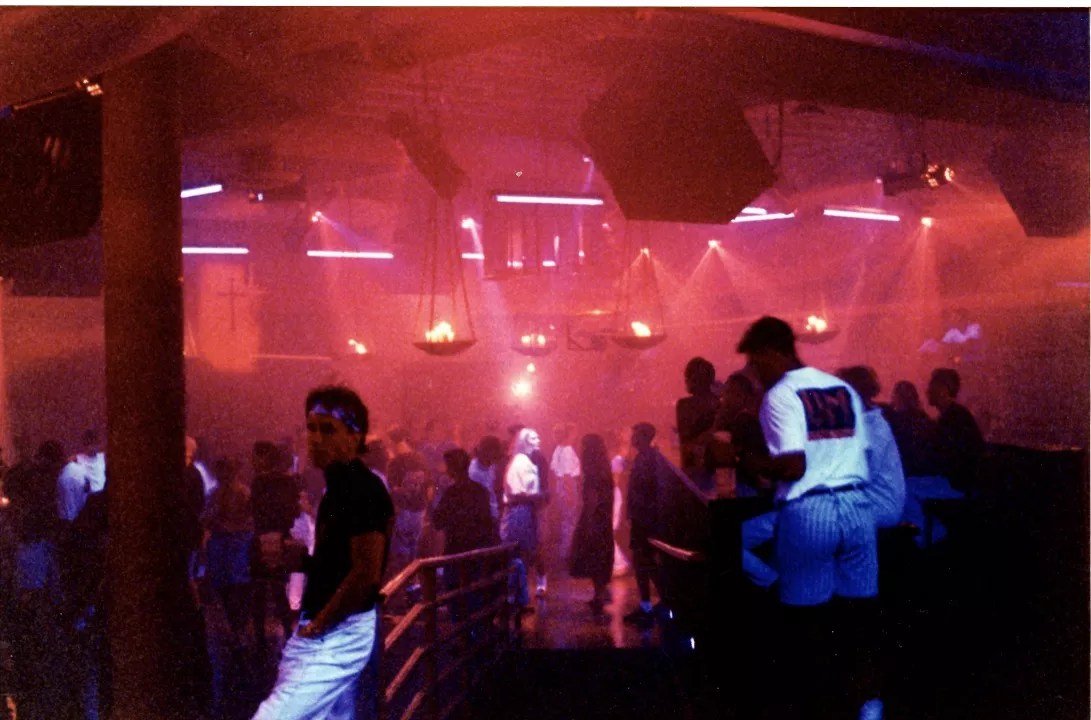
The main room at The Works in Scottsdale.
Steven Rogers
Christian Harding, former regular at The Works: It had such great sound. I remember the bass wall where they had all the subwoofers on one side, and you could go over there and stand in front of it and bang your head and listen to the bass and dance your ass off.
Jeffs: There weren’t many seats and tables. In essence, it really was built to be a dance club. The DJ booth was up on the second story overlooking everything. The bar was off to the side, and it was huge, too.
Sarah Gianetto, former regular of The Works: There were these leveled dance risers in the middle so you could find a lot of open space instead of being crammed in the middle of a dance floor. They had a catwalk over the middle of the dance floor where go-go dancers danced all the time. I got to dance up there sometimes.
Schulz: Greg said, “I want all the rave kids here,” and then Steven said, “I want the gay community here.” And on opening night, it was such a beautiful mixture of people. It was like guys in chaps, and girls with fuzzy boots, and just music that nobody had ever heard before.
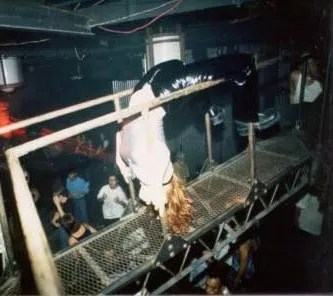
Sarah Gianetto dances on the catwalk at The Works.
Sarah Gianetto
Amador: I stood in the [DJ booth] overlooking the dance floor. I could look out and see people’s faces on the dance floor. It felt like an honor to go up to the DJ booth and play. I was very influenced by Frankie Knuckles, Tony Humphries, Masters at Work … that was the house I was playing at the beginning.
Jeffs: It had the feel of a gay club, but the crowd was far more mixed. It was 18 to 35 [year-olds]. It was black, white, Asian, gay, straight, just all walks of life. If you were into electronic music, house music, club music, and underground music, that’s where you went on a Friday or Saturday night. It felt more like a rave than a club.
Burwell: The club kids all came because that’s when Michael Alig and the Club Kids stuff was really going on in other places, and this was as close as we got to that going on out here. People would wear the craziest stuff. Freshjive was a thing. JNCO was a thing, those huge pants. Mostly, it was about what you could find at a thrift store and make into something funny.
David Van Virden, former regular at The Works: Everybody tried to outdo each other, so there was always just more color, more shock, and more Spandex, and more everything you could imagine.
Harding: People-watching was half of the fun. You could just watch all the people in different outfits, and it was just great.
Van Virden: During the early years, everybody showed up: all the freaks, all the drag queens, all the gays who maybe didn’t have a place, and straight people, too. They really didn’t discriminate, and Steve didn’t either. He welcomed all comers.
Schulz: [The Works] kind of started something that people had never seen. And it started the word of mouth. And what it evolved into was a community in and of itself. All of us from The Works, whether it’s the clubbers or people that worked there, we didn’t belong anywhere else. We were all outcasts. But at The Works, that was our community.
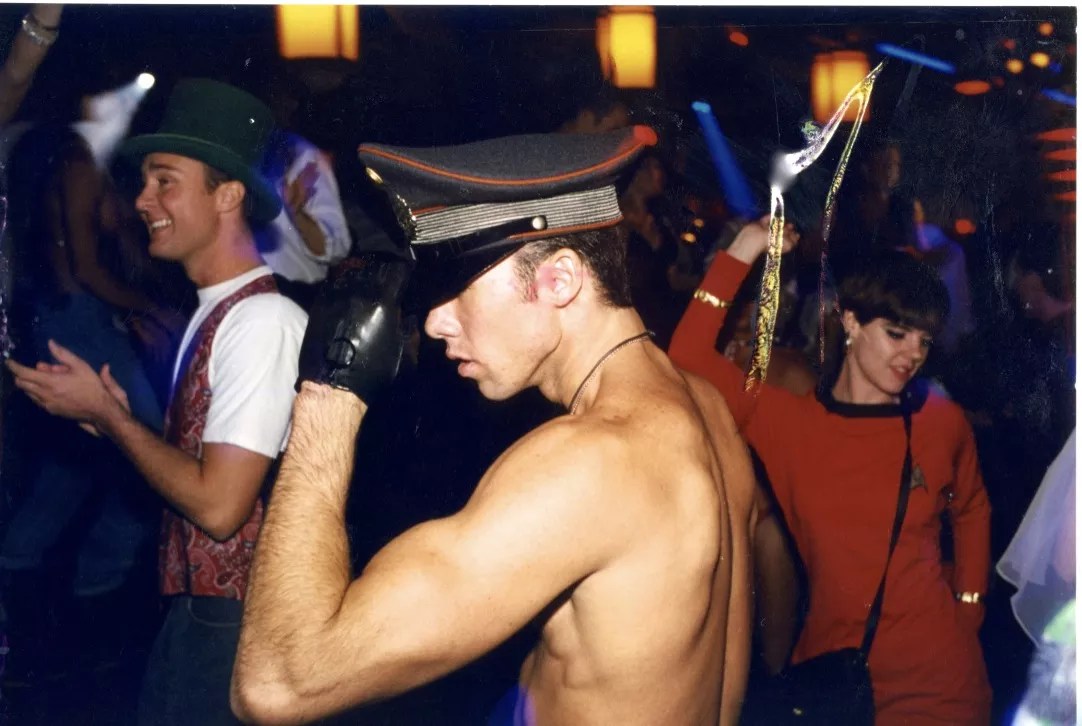
Patrons of The Works back in the day.
Steven Rogers
Harding: It was pretty much all different kinds of people, all different walks of life. It was just like a family. You don’t see that kind of club anymore. For us, it was an after-hours place and a place that we could dance and get sweaty.
Gianetto: I felt super-comfortable there. The Works was like home. I’d be approached by dudes on the dance floor, but not very much, but it wasn’t like places that were filled with creeps.
Burwell: You used to fight to be at the top of the dancer risers. And if you danced a lot at The Works as a regular, you got in free. It was really cool.
Harding: The first night that we went, I remember somebody coming up to me and saying, “Oh, you’re a really great dancer. Would you be interested in becoming a dancer for The Works?” And of course, if that was a way to hop the line so you didn’t have to wait for four hours outside, that’s what I did.
Burwell: There was a time when Steven was trying to sell membership cards. So if you had a membership, you would get in line before anybody, you could get to VIP events and all kinds of stuff. At the time, it had a proper door policy. You could wait for hours just to get in.
Schulz: There was nothing like The Works back then. It was nothing even close. Like all those [other bars] appealed to the normal person. Us as weirdos, we would go to those other clubs and we wouldn’t fit in. But when we got to The Works, that was our place. And then, eventually, normal people would come to The Works and they would be like, “Whoa!”
Harding: There used to be this old couple that would go to The Works, and they literally had to be in their 60s, a husband and wife. I’ll never forget them. He always wore this tight turtleneck shirt and she always wore all these big colorful outfits. And I remember all of us looking at them and going, “God, I hope we’re like them when we get older.” And of course, most of us aren’t.
Burwell: There was just a really interesting, creative fun vibe and there were no rules; you could do what you want and nobody cared. And so, it felt totally freeing and liberating.
As word spread about The Works, it became even more popular. The crowds grew and the times got even wilder.
Rogers: Everyone talks about all kinds of crazy things going on in The Works. Well, it was organized chaos, and when people came in, it had that feeling because they had come from such a uniformed, structured world. It felt so “anything goes” that some people would fucking go wild.
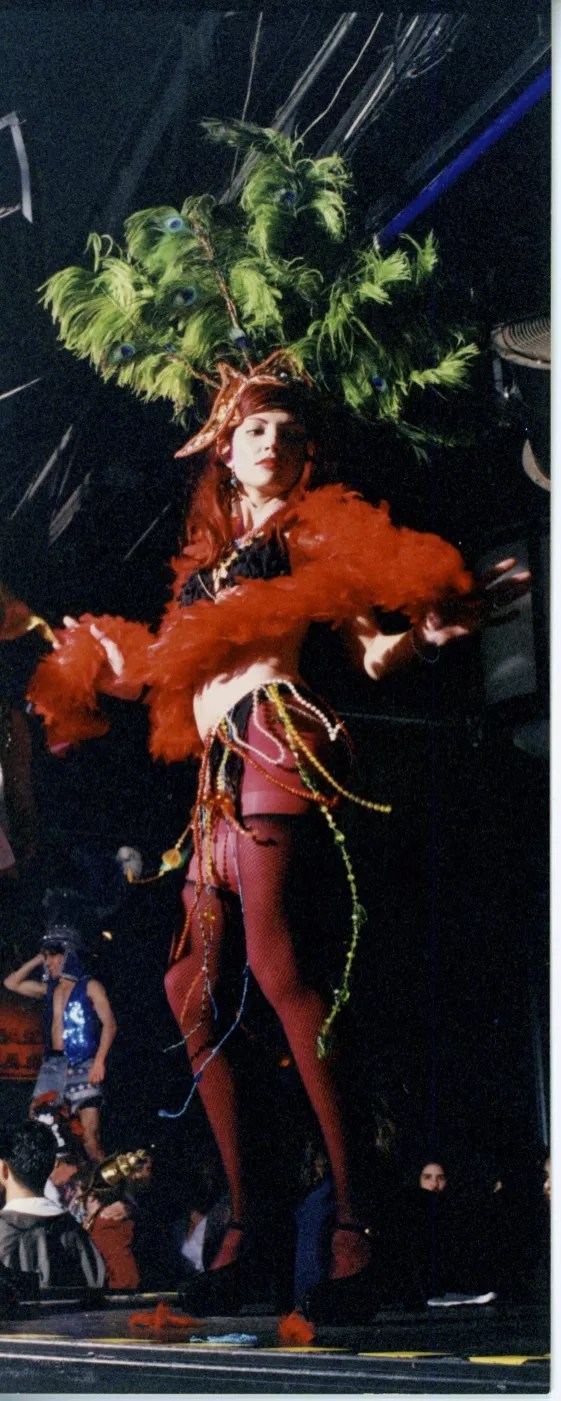
A costumed patron of The Works.
Steven Rogers
Van Virden: They had underwear nights, which were a weekly thing. It was great. It was a little bit more controversial than what Scottsdale was used to at the time. Now, of course, probably nothing to even, like, raise an eyebrow over, but at the time it was pretty amazing.
Rogers: Fashion Square Mall was open then, and I used to get calls from Dillard’s thanking me because they’d sell out of underwear those nights.
Burwell: It was at the time when [The Works] was an outlet for people who were gay. Back then, AIDS was still a major thing, ACT UP had barely started in town, and, if you were gay, you were getting beaten to death with crowbars in parking lots. Gay bars were totally dangerous places. So, the fact that you had a place like The Works that was in Scottsdale that someone opened, it really felt like a safe space.
Rogers: There was a lot of gay energy, but it wasn’t typically or demographically gay. I didn’t consider it gay at all. It had to be 75 percent straight. Pansexual would’ve been a better word for what was going on in there.
Harding: They’d have these big drag shows on Halloween, and you’d have everybody coming in costumes. And that was awesome.
Van Virden: Halloweens were when everybody went for it, so they were pretty decadent, and everybody looked amazing. The fun part was towards the end of the evening when everybody’s makeup’s slipping off, and you see like Dracula throwing up in the backyard or something like that. But, yeah, they were pretty crazy.
Burwell: Around then, David Van Virden was putting out his newsletter, The U Report, which was a big, old gossip rag. He used to cover everything that was going on.
Van Virden: I was always dishing the dirt. But, that was back then. It’s nothing like the dirt there is now.
Burwell: There were also celebrities who came into The Works all the time.
Schulz: I remember seeing Charles Barkley in there. I remember seeing Dan Majerle walking through. I remember Pamela Anderson walking in. It was just all these people would come and check it out and they would be like, “Whoa, what in the world is this?” It was like a different world. It was special.
Rogers: Stars were coming in. I met Christopher Walken. We had RuPaul, but no one knew who RuPaul was yet.
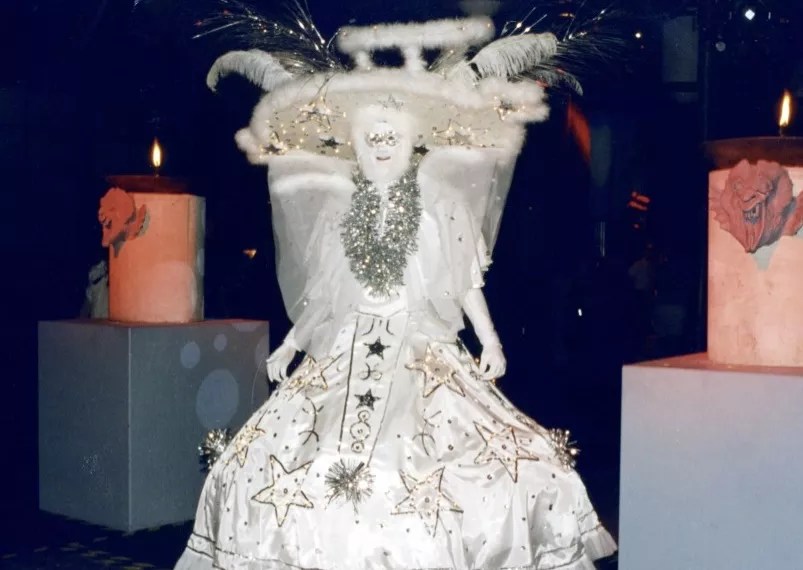
A costumed patron of The Works.
Steven Rogers
Van Virden: I had an interview with RuPaul at The Works, who was doing a little show there. We sat down and had a really nice conversation. I’ll never forget that.
Burwell: Some of U2 came in during their Zoo TV tour when it was at [Sun Devil Stadium]. Bono didn’t come, but it was their tour manager and Adam Clayton.
Jeffs: The first live electronic show I saw there was Prodigy and Moby in 1993. They played with John Acquaviva, Richie Hawtin, and Plus 8 sound system. There was like 150 of us there for that show, like the core of the Phoenix rave scene was there.
Burwell: At that time, Moby was a straight-edge, Christian vegan, which was the weirdest mix you could imagine at the time. The Gentle Strength Co-Op was open in Tempe then, and I remember him getting really excited about that. He bought bags and bags of food because, if you were a vegan, you ate just apples and peanut butter.
Gianetto: I fell asleep during Moby’s set, but woke up because he played “Thousand” and was standing on top of his keyboards.
Jeffs: Prodigy put on a great show; Moby put on a great show. It was really interesting to see live electronic music for the first time. Prodigy was running around onstage, and whereas Moby just got up there and did his thing.
Amador: When The Works took off, that’s when the rave scene was in full-blown mode around the world and it was all about techno/rave music … and that was more like Prodigy, Moby, Joey Beltram, and The Chemical Brothers. The rave scene became so massive that I had to address that, too. So Friday nights were the soul sessions and it was just more New York/Chicago house music, whereas Saturday nights were more popular because it was energetic techno music. It was like a rave every Saturday night.
Jeffs: Eddie was very cutting-edge for house music at the time; he was playing a lot of Chicago and West Coast-vibe house.
Rogers: People from the city of Scottsdale would come in and they’d see these people on these dance boxes. And the truth of the matter was, in the beginning, I hired some dancers, and they came from various places, and a few of them were basically like stripper-type dancers. But they weren’t really stripping, they were just sexy. And the city freaked out about that. It got to the point where they were looking at the dance floor to see if there was any kind of suggestive dancing happening. This was Scottsdale in [the early ’90s], like Quaker town.
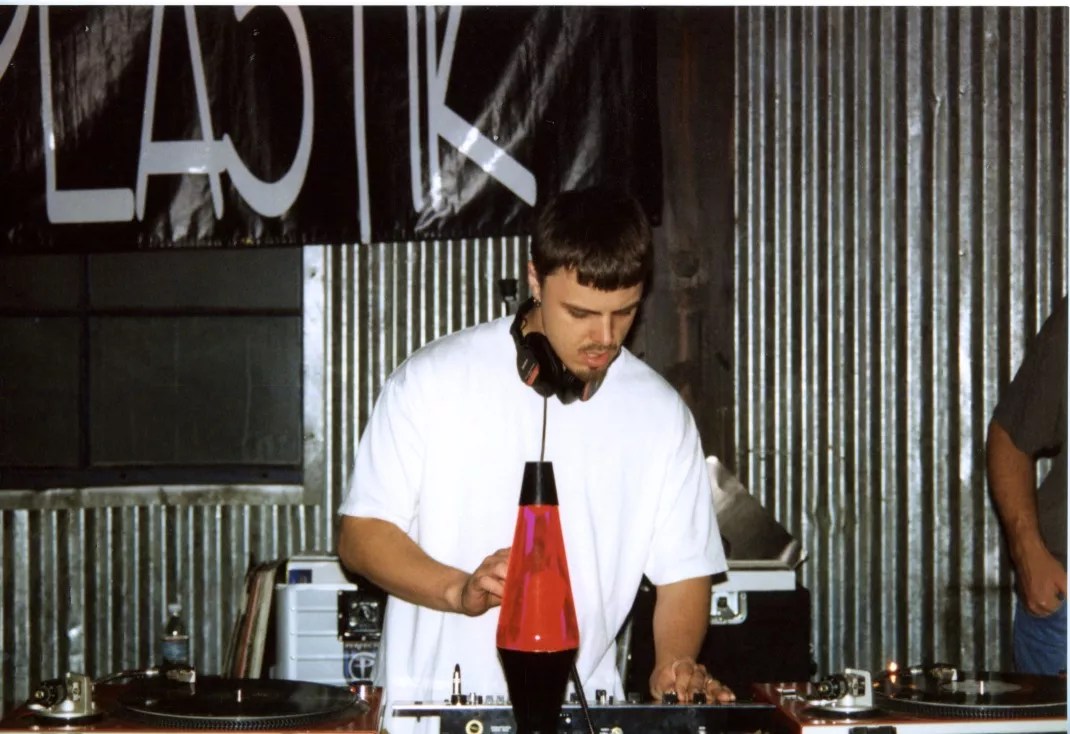
Markus Schulz DJs at The Works in the ’90s.
Steven Rogers
Over the next few years, The Works began to change. It added a side bar and an outdoor pool. Eddie Amador eventually left after Markus Schulz started DJing at the club. It changed the vibe at the club.
Rogers: My partner as the time, Greg Walker, said, “I want you to meet this guy [Markus]. I think he might be a good DJ.” So I did, and I liked him, but didn’t think too much of it. I was just trying to run a business. First of all, he was the only professional DJ I’d ever worked with, but from the get-go, Markus was a different kind of person. He eventually became our resident DJ after Eddie.
Amador: After the first two years I got burnt out. As an artist, my mind was splitting between what was soulful and what was popular. Like how could I be Muddy Waters one night and Mick Jagger the next? So I decided to just stay with the house music stuff. And that’s when Markus Schulz came into it. Steven saw that I wanted to do more house music and asked if I wanted to take Saturday nights off and let Markus take over. I was like, “Gladly. Let me have Friday nights and I can concentrate on keeping it house-y and Markus goes on Saturdays.”
Schulz: The Works gave me the opportunity to experiment. I made some programming mistakes, but I learned from it and I grew as an artist.
Rogers: Markus was the most professional DJ I’d ever worked with at the time. He had connections, he had a radio gig, he had everything.
Amador: [Markus] was able to work it more, because he had more connections around the world through this mix show he had on the radio. That was the beginning of the peak period. And I eventually moved on after that and pursued house music elsewhere.
Burwell: I think when Eddie left and they brought in Markus Schulz was a big change. Some people didn’t like that fact because Markus was more professional, more corporate. At the time, he had a radio gig [the now-defunct EDM show The Edge Factor] and made remixes. Everyone recognized that Markus was really talented, but it just felt less underground. It was just different. It went from being more of an underground freakfest and became more fancy.
Steve LeVine, event promoter and owner of Steve LeVine Entertainment: Markus’ music was always progressive, like this melodic trance vibe, but it would hit hard, and he took you on these journeys. Being at The Works led to all these different opportunities for him, between what he did on [now-defunct local radio station The Edge] and his record store in Tempe, Plastik Records.
Burwell: They’d made so many changes [to The Works]. In the beginning, it was the first of its kind, but then it became more of an entertainment complex. Over time, they developed a whole VIP club/side bar that attached to to the main room. So it wasn’t the same place and a lot of the trendy club kids moved on.
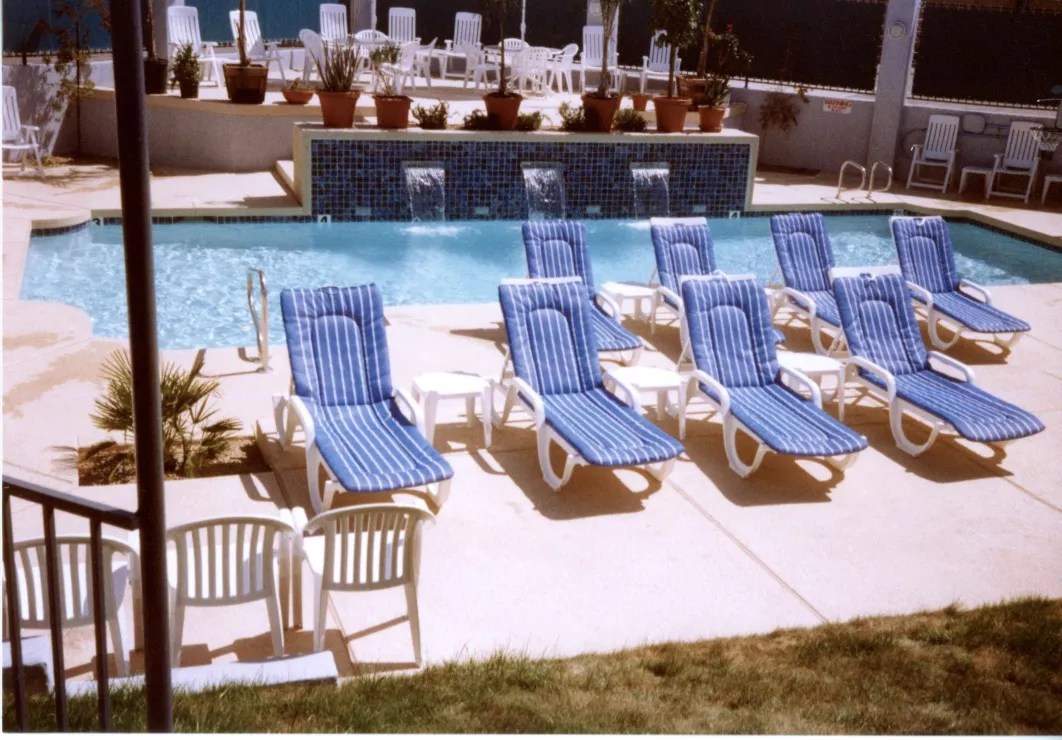
The pool area at The Works.
Steven Rogers
LeVine: I was a regular in like ’94 or ’95, and I went all the time. The main room was all dance and trance, and the side room was all Beastie Boys and Nirvana, like rock and pop.
Harding: The people that liked to dance never went into the [side] bar. During after hours, the small bar was kind of filled with the sports guys, the frat guys, the pretty girls, and everyone else was in the main room.
Van Virden: It was fantastic when they built the pool. I think it was the first day-drinking pool bar in Scottsdale. It was revolutionary, and it was absolutely amazing.
LeVine: I remember my friends rented out that pool and a had a full-blown pool party with a DJ, which was never heard of back then. And now you look at clubs today like Maya [Day & Nightclub] with the same thing. So The Works was ahead of its time.
Throughout its five-year lifespan, The Works had to deal with constant visits from the Scottsdale Police Department. Various incidents occurred outside the club from 1994 to 1996, including a pair of shootings.
Rogers: It felt like they were trying to shut me down. It felt like there was this vision of Scottsdale as the “West’s most western town”: extremely conservative, very white, and very straight. And then right next to City Hall, this big warehouse opens that has people standing in line, 1,000 deep in their underwear … and that totally blew their minds. … There was a night where I had police helicopters overhead, mounted police officers in the parking lot, and a line of people in underwear wrapped around the place. It was insane.
Burwell: Cops came by all the time.
Harding: I remember a couple of times when idiot [patrons] would release tear gas inside the club and they’d have to call the cops. Or they’d squirt their pepper spray, I guess, into the intake vents, and the entire club would be cleared out because of the pepper gas in the place. Amongst all the good times and the good memories were definitely a bunch of jackholes that wanted to ruin it for everybody. … There was a shooting where a guy got shot in the stomach or in the leg or something like that. Ultimately, I think, that’s what got The Works shut down, is they had shootings in the parking lot or outside of the club.
“If you’re driving around right now, just coming from a club or something, what you need to do is head right over to The Works. In case you haven’t heard, this is their last night open.” — Markus Schulz on The Edge Factor, fall 1997
The Works closed in fall 1997 after its lease expired and the landowner wanted to turn the property into a parking lot. Schulz felt like the party was over.
Schulz: To be honest, it needed to close. I say that with a heavy heart. You could kind of feel it. At the time, the internet started popping up and growing. It was just that the times were changing, and there was something about how you didn’t want the original message or the original soul of the club to change. And as we got closer towards the turn of the millennium, you could feel that things were starting to change.
Harding: I remember that the last few nights of The Works, where they had their farewell party, those were just incredible. Josh Wink came as one of the last performances.
Schulz: The final night, it was so sad. The normal closing time was around 4 or 5 a.m. And I remember, 4 o’clock rolled around, nobody wanted to leave. 5 o’clock rolled around, nobody wanted to leave. And you knew that every song could be the last song at any point. And you just kept pulling out track after track after track, kept playing another one and another one and nobody was leaving. And it was just crazy. And I remember after the last song finally ended, people were in tears. Because it was people who had been going there for five years were all there at the end.
Obviously, during that night, it was completely packed with lines around the building. But at that time. It must have been 6 a.m., the sun was shooting through the cracks in the ceiling, and it was just the last of the hardcore people. Everybody was a familiar face that was there at the end. And all of the people that needed to be there were there.
Gianetto: I have to say, the saddest day was when they turned The Works site into a parking lot. But I guess being completely obliterated is better than something having to live up to a legendary past.
Van Virden: Steve created a template for all these other clubs down there in [Scottsdale’s] entertainment district. He really was the originator, and that club was copied over and over and over again to varying degrees of success.
LeVine: The Works set the stage for later clubs, like Pompeii in Tempe, which became Club Freedom, which was very similar to what was at The Works.
Schulz: In the end, The Works, for me at least, was where I got to figure out who I was as an artist. After it closed, I moved to London, and it was a pilgrimage. But when I was at The Works, I knew that this is what I needed to be doing, and this is what I needed to pursue, and The Works gave me the opportunity.
Markus Schulz is scheduled to perform Friday, August 23, at Shady Park in Tempe. Tickets are $25 via relentlessbeats.com.